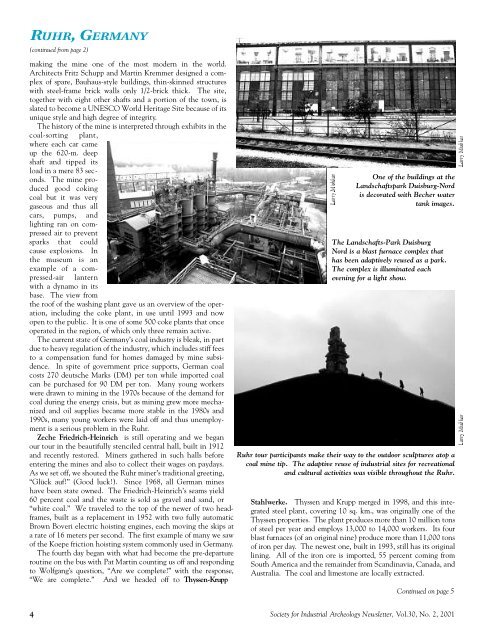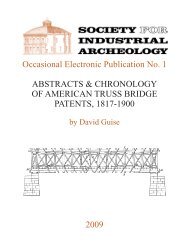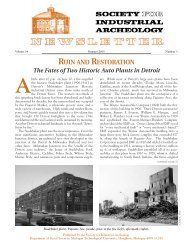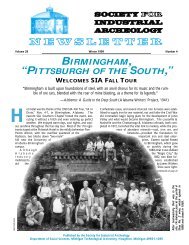RUHR, GERMANY - Society for Industrial Archeology
RUHR, GERMANY - Society for Industrial Archeology
RUHR, GERMANY - Society for Industrial Archeology
Create successful ePaper yourself
Turn your PDF publications into a flip-book with our unique Google optimized e-Paper software.
<strong>RUHR</strong>, <strong>GERMANY</strong><br />
(continued from page 2)<br />
making the mine one of the most modern in the world.<br />
Architects Fritz Schupp and Martin Kremmer designed a complex<br />
of spare, Bauhaus-style buildings, thin-skinned structures<br />
with steel-frame brick walls only 1/2-brick thick. The site,<br />
together with eight other shafts and a portion of the town, is<br />
slated to become a UNESCO World Heritage Site because of its<br />
unique style and high degree of integrity.<br />
The history of the mine is interpreted through exhibits in the<br />
coal-sorting plant,<br />
where each car came<br />
up the 620-m. deep<br />
shaft and tipped its<br />
load in a mere 83 seconds.<br />
The mine produced<br />
good coking<br />
coal but it was very<br />
gaseous and thus all<br />
cars, pumps, and<br />
lighting ran on compressed<br />
air to prevent<br />
sparks that could<br />
cause explosions. In<br />
the museum is an<br />
example of a compressed-air<br />
lantern<br />
with a dynamo in its<br />
base. The view from<br />
the roof of the washing plant gave us an overview of the operation,<br />
including the coke plant, in use until 1993 and now<br />
open to the public. It is one of some 500 coke plants that once<br />
operated in the region, of which only three remain active.<br />
The current state of Germany’s coal industry is bleak, in part<br />
due to heavy regulation of the industry, which includes stiff fees<br />
to a compensation fund <strong>for</strong> homes damaged by mine subsidence.<br />
In spite of government price supports, German coal<br />
costs 270 deutsche Marks (DM) per ton while imported coal<br />
can be purchased <strong>for</strong> 90 DM per ton. Many young workers<br />
were drawn to mining in the 1970s because of the demand <strong>for</strong><br />
coal during the energy crisis, but as mining grew more mechanized<br />
and oil supplies became more stable in the 1980s and<br />
1990s, many young workers were laid off and thus unemployment<br />
is a serious problem in the Ruhr.<br />
Zeche Friedrich-Heinrich is still operating and we began<br />
our tour in the beautifully stenciled central hall, built in 1912<br />
and recently restored. Miners gathered in such halls be<strong>for</strong>e<br />
entering the mines and also to collect their wages on paydays.<br />
As we set off, we shouted the Ruhr miner’s traditional greeting,<br />
“Glück auf!” (Good luck!). Since 1968, all German mines<br />
have been state owned. The Friedrich-Heinrich’s seams yield<br />
60 percent coal and the waste is sold as gravel and sand, or<br />
“white coal.” We traveled to the top of the newer of two headframes,<br />
built as a replacement in 1952 with two fully automatic<br />
Brown Boveri electric hoisting engines, each moving the skips at<br />
a rate of 16 meters per second. The first example of many we saw<br />
of the Koepe friction hoisting system commonly used in Germany.<br />
The fourth day began with what had become the pre-departure<br />
routine on the bus with Pat Martin counting us off and responding<br />
to Wo l f g a n g ’s question, “Are we complete?” with the response,<br />
“ We are complete.” And we headed off to T h y s s e n - K r u p p<br />
One of the buildings at the<br />
Landschaftspark Duisburg-Nord<br />
is decorated with Becher water<br />
tank images.<br />
The Landschafts-Park Duisburg<br />
Nord is a blast furnace complex that<br />
has been adaptively reused as a park.<br />
The complex is illuminated each<br />
evening <strong>for</strong> a light show.<br />
Ruhr tour participants make their way to the outdoor sculptures atop a<br />
coal mine tip. The adaptive reuse of industrial sites <strong>for</strong> recreational<br />
and cultural activities was visible throughout the Ruhr.<br />
Stahlwerke. Thyssen and Krupp merged in 1998, and this integrated<br />
steel plant, covering 10 sq. km., was originally one of the<br />
Thyssen properties. The plant produces more than 10 million tons<br />
of steel per year and employs 13,000 to 14,000 workers. Its four<br />
blast furnaces (of an original nine) produce more than 11,000 tons<br />
of iron per day. The newest one, built in 1993, still has its original<br />
lining. All of the iron ore is imported, 55 percent coming from<br />
South America and the remainder from Scandinavia, Canada, and<br />
Australia. The coal and limestone are locally extracted.<br />
Continued on page 5<br />
4 <strong>Society</strong> <strong>for</strong> <strong>Industrial</strong> <strong>Archeology</strong> Newsletter, Vol.30, No. 2, 2001






